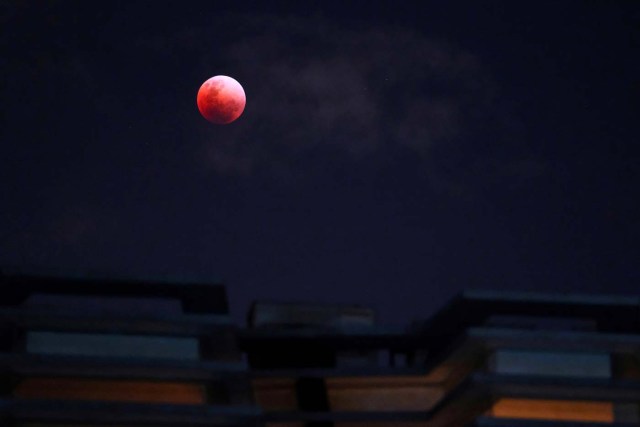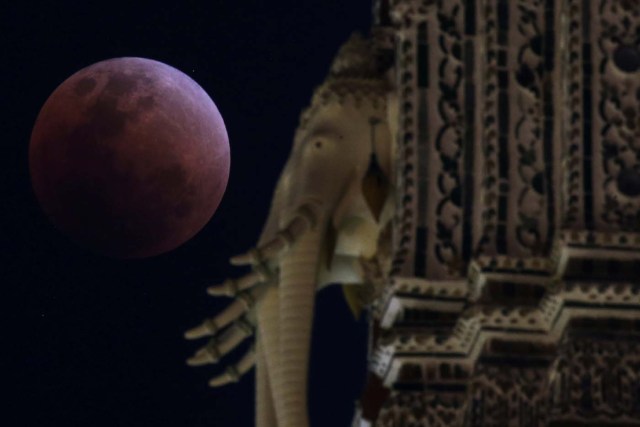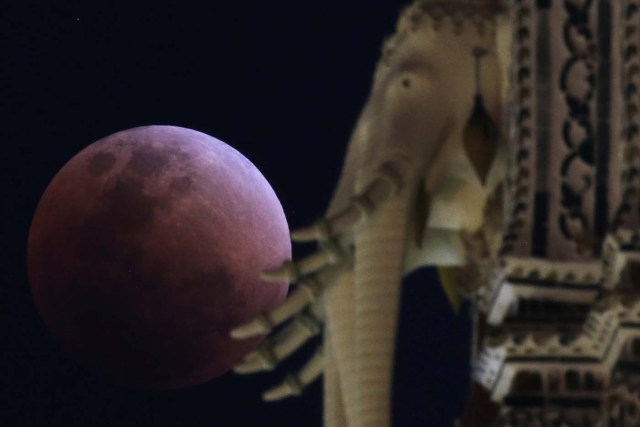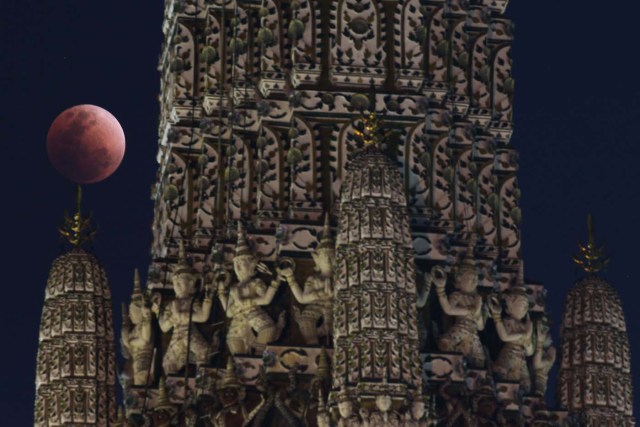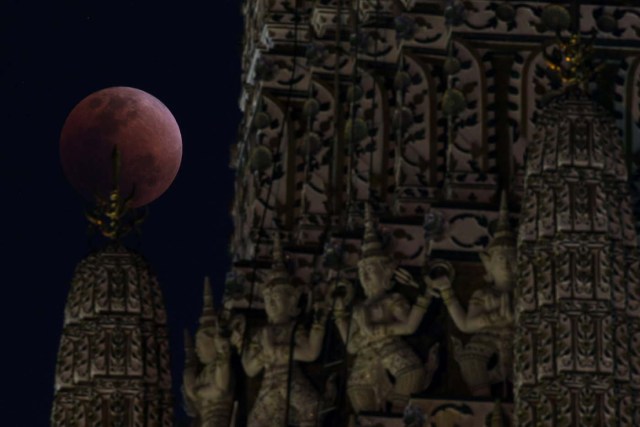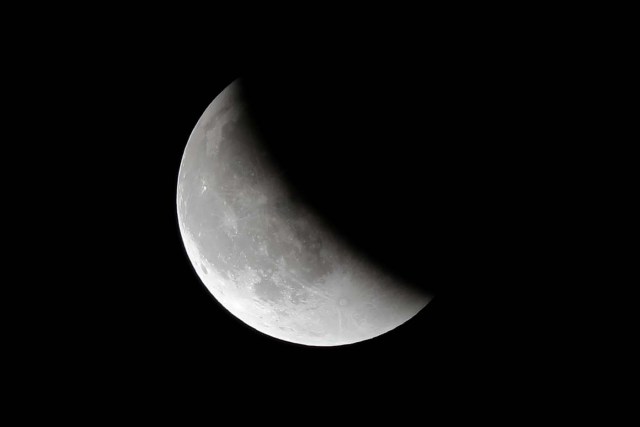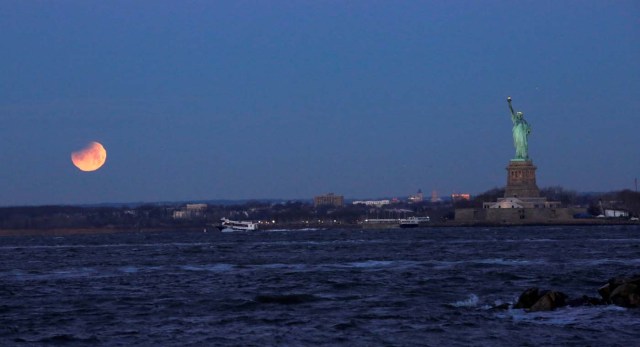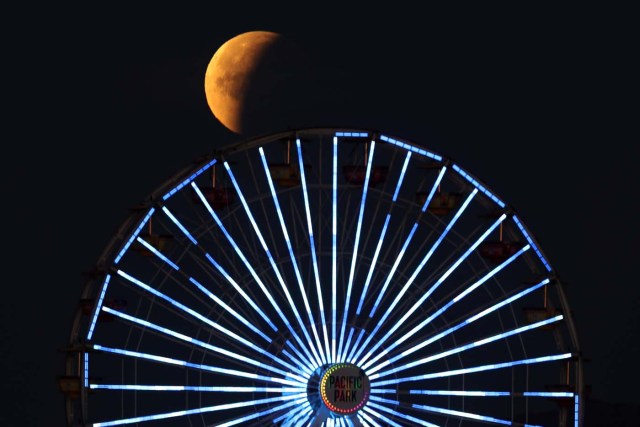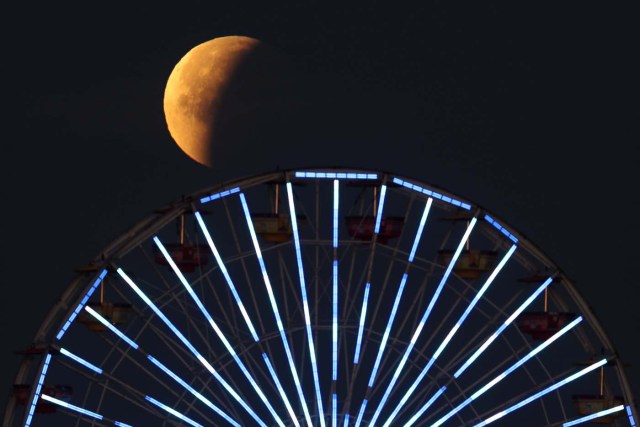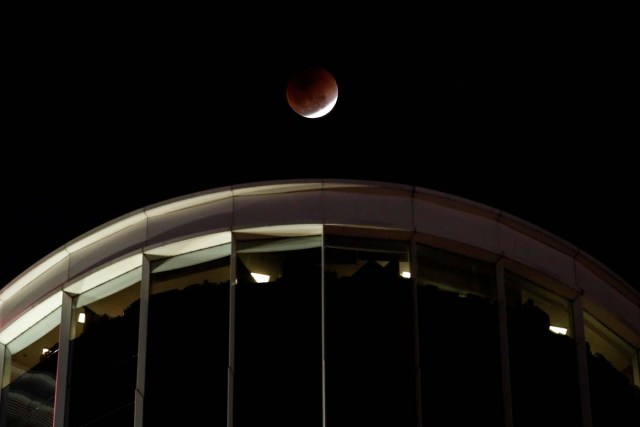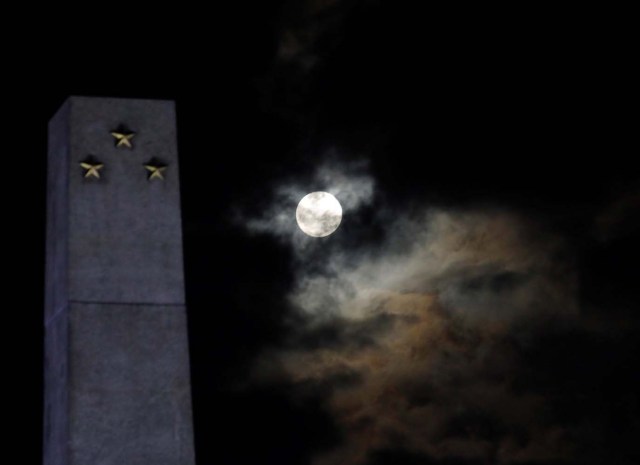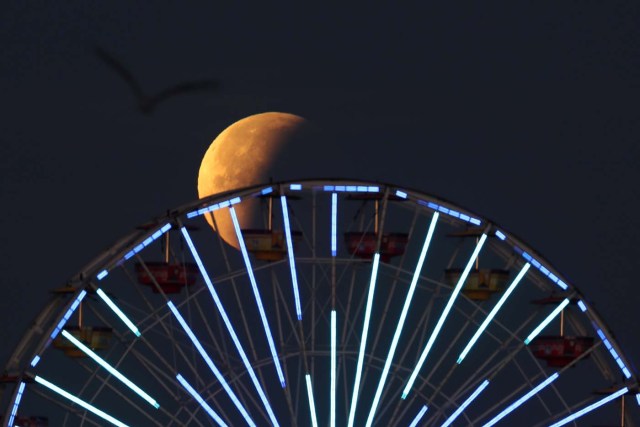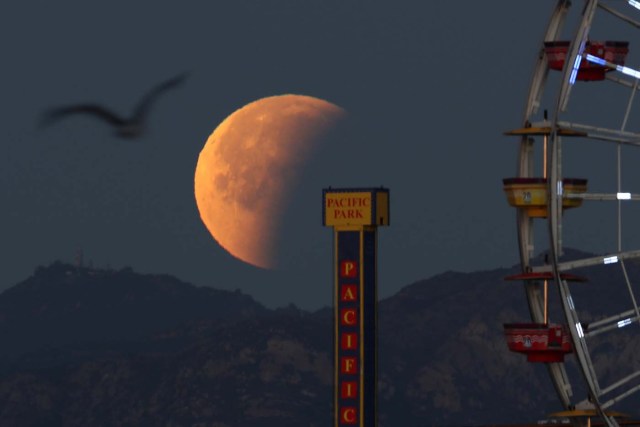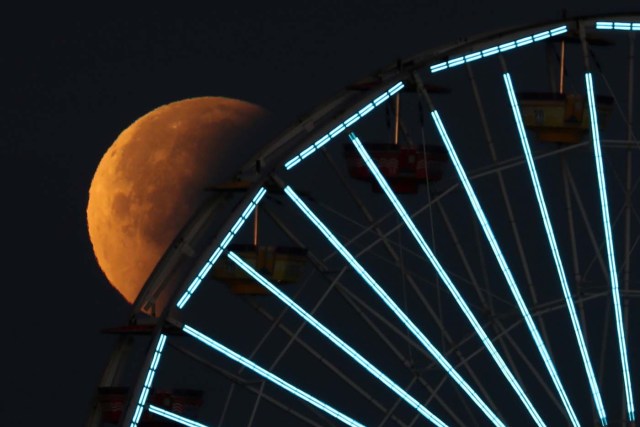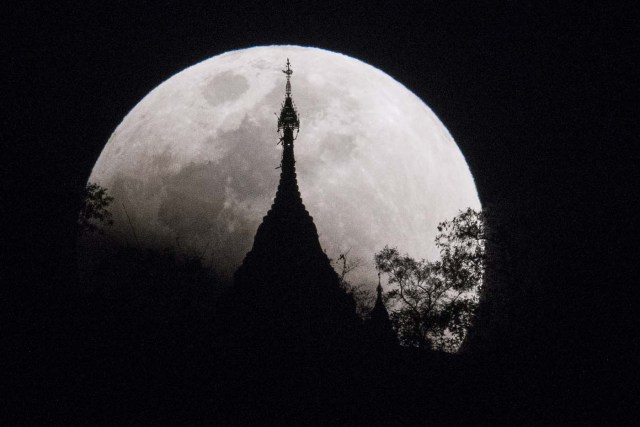
Cercana, grande y “sanguínea”: un eclipse lunar total, particularmente raro por su tamaño, dio este miércoles un espectáculo visible en gran parte del planeta.
En California, miles de personas observaron durante la noche la llamada “superluna azul de sangre”, que desapareció, privada de rayos de sol, y volvió a emerger teñida de rojo, de ahí su nombre.
También se le llama “azul” no por el color sino porque se trata de la segunda luna llena en un mes, un fenómeno que solo sucede en promedio cada dos años y medio.
Algunas personas esperaron más de cinco horas con la esperanza de encontrar un buen lugar en el observatorio Griffith de Los Ángeles, que abrió sus puertas a las 03H30 locales para recibir a unos 2.000 espectadores.
El eclipse comenzó a las 03H45 locales (11H45 GMT), con una sombra negra comenzando a cubrir la Luna blanca. Una hora más tarde quedó completamente cubierta y después empezó a reaparecer, con un tono cobrizo que había cubierto su superficie.
El espectáculo fue observable en parte de América del Norte, Rusia, Asia y el océano Pacífico. En cambio, la mayor parte de Europa, América del Sur y África no pudieron seguirlo debido a la luz del sol.
En América del Norte, en Alaska o Hawái, el eclipse fue visible antes del alba. En Oriente Medio, Asia, Rusia Oriental, Australia y Nueva Zelanda, el eclipse se desarrollaba al salir la Luna en la noche de este miércoles.
Contrariamente a los eclipses solares, las gafas de protección no son necesarias para ver el fenómeno.
– Un regalo raro –
El satélite de la Tierra se tiñó de rojo debido a un fenómeno luminoso: los rayos del sol que atraviesan la atmósfera se “difunden”, excepto los rojos, que son desviados por la atmósfera iluminando la superficie lunar.
“El color rojo apareciendo durante el eclipse lunar es muy particular, es un regalo raro poder observar una luna sanguínea”, dijo Brian Rachford, profesor asociado de física en la universidad estadounidense de Embry-Riddle Aeronautical.
El eclipse fue especialmente esperado porque la luna presentó “tres especificidades a la vez”, confirmó el Observatorio de París en su página web: no es sólo “azul” y “sanguínea”, también es “súper”, porque el astro está este miércoles muy cerca de la Tierra.
El eclipse ocurrió 27 horas después de que la Luna alcanzara su punto orbital más cercano a nuestro planeta, llamado perigeo. Por lo tanto, se vio un poco más grande que de costumbre, “alrededor de 7% (más) respecto a una Luna media, lo que permitirá distinguir más fácilmente a simple vista sus zonas de sombras y contrastes”, según el Observatorio de París.
La última superluna “azul de sangre” se produjo el 30 de diciembre de 1982 y fue visible en Europa, África y en el oeste de Asia. En América del Norte ocurrió hace 152 años, el 31 de marzo de 1866.
El próximo fenómeno similar está previsto el 31 de enero de 2037.
AFP

Skywatchers were hoping for a rare lunar eclipse that combines three unusual events — a blue moon, a super moon and a total eclipse — which was to make for a large crimson moon viewable in many corners of the globe. / AFP PHOTO / YE AUNG THU
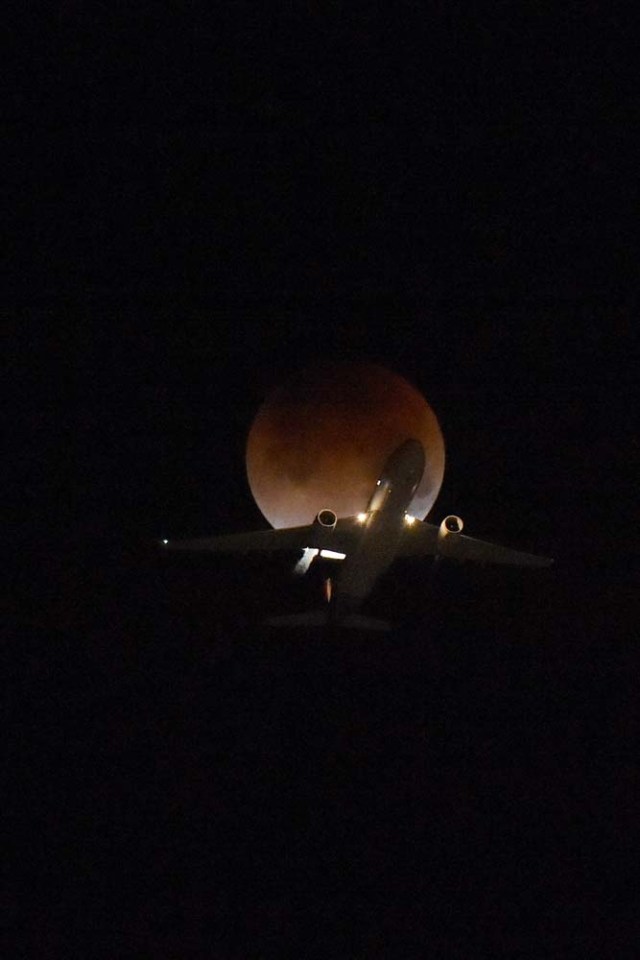
Many parts of the globe may catch a glimpse on January 31 of a giant crimson moon, thanks to a rare lunar trifecta that combines a blue moon, a super moon and a total eclipse. The spectacle, which NASA has coined a “super blue blood moon.” The celestial show is the result of the sun, Earth, and Moon lining up perfectly for a lunar eclipse just as the Moon is near its closest orbit point to Earth, making it appear “super” large.
/ AFP PHOTO / Robyn BECK
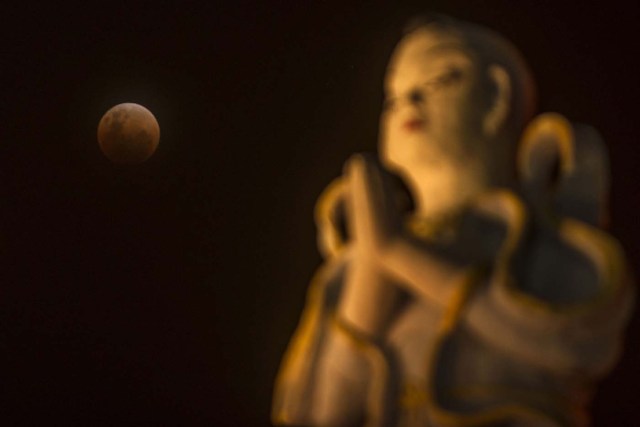
Skywatchers were hoping for a rare lunar eclipse that combines three unusual events — a blue moon, a super moon and a total eclipse — which was to make for a large crimson moon viewable in many corners of the globe. / AFP PHOTO / JUNI KRISWANTO
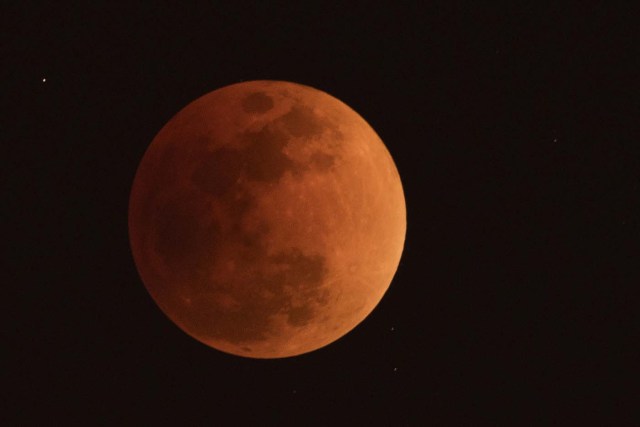
Skywatchers were hoping for a rare lunar eclipse that combines three unusual events — a blue moon, a super moon and a total eclipse — which was to make for a large crimson moon viewable in many corners of the globe. / AFP PHOTO / NICOLAS ASFOURI
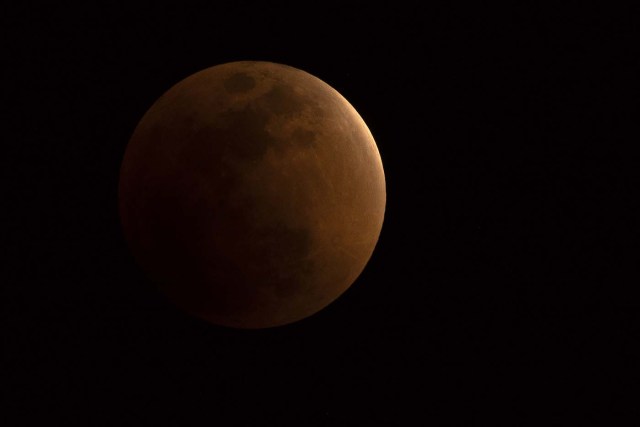
Skywatchers were hoping for a rare lunar eclipse that combines three unusual events — a blue moon, a super moon and a total eclipse — which was to make for a large crimson moon viewable in many corners of the globe. / AFP PHOTO / NICOLAS ASFOURI
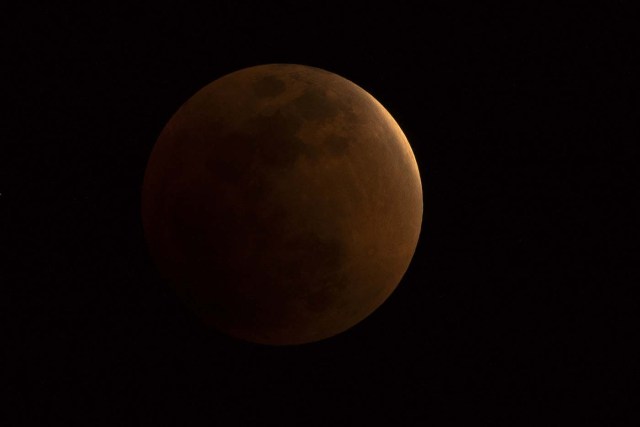
Skywatchers were hoping for a rare lunar eclipse that combines three unusual events — a blue moon, a super moon and a total eclipse — which was to make for a large crimson moon viewable in many corners of the globe. / AFP PHOTO / NICOLAS ASFOURI
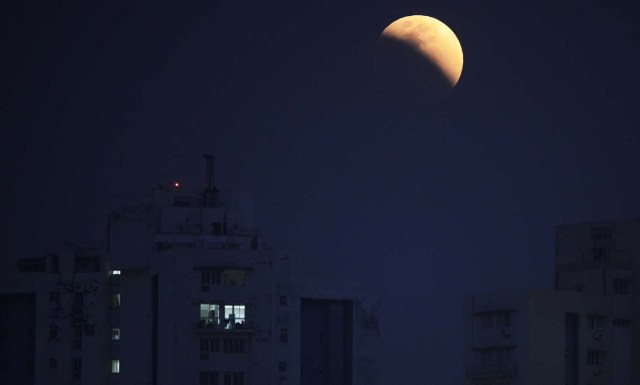
Skywatchers were hoping for a rare lunar eclipse that combines three unusual events — a blue moon, a super moon and a total eclipse — which was to make for a large crimson moon viewable in many corners of the globe / AFP PHOTO / Dibyangshu SARKAR
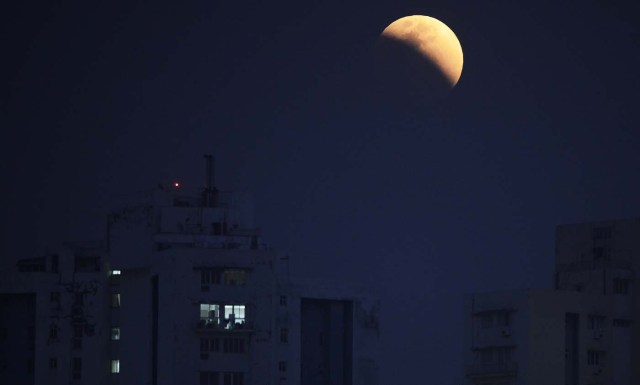
Skywatchers were hoping for a rare lunar eclipse that combines three unusual events — a blue moon, a super moon and a total eclipse — which was to make for a large crimson moon viewable in many corners of the globe / AFP PHOTO / Dibyangshu SARKAR

Skywatchers were hoping for a rare lunar eclipse that combines three unusual events — a blue moon, a super moon and a total eclipse — which was to make for a large crimson moon viewable in many corners of the globe / AFP PHOTO / Dibyangshu SARKAR

Skywatchers were hoping for a rare lunar eclipse that combines three unusual events — a blue moon, a super moon and a total eclipse — which was to make for a large crimson moon viewable in many corners of the globe / AFP PHOTO / Dibyangshu SARKAR
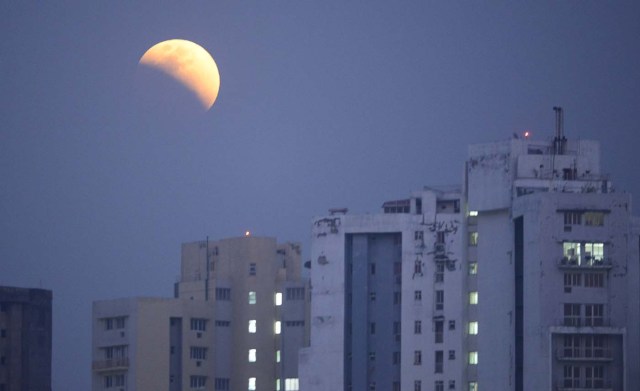
Skywatchers were hoping for a rare lunar eclipse that combines three unusual events — a blue moon, a super moon and a total eclipse — which was to make for a large crimson moon viewable in many corners of the globe / AFP PHOTO / Dibyangshu SARKAR
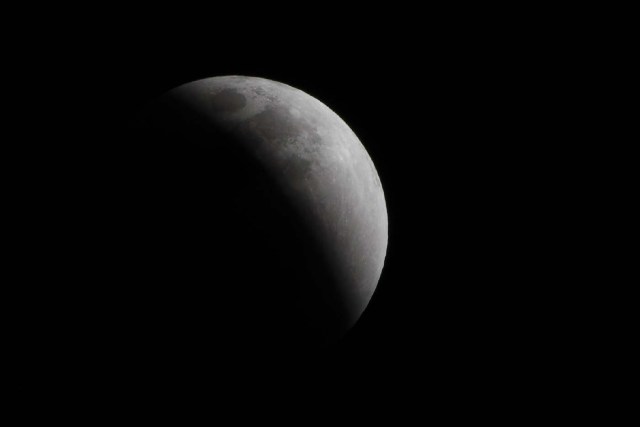
Skywatchers were hoping for a rare lunar eclipse that combines three unusual events — a blue moon, a super moon and a total eclipse — which was to make for a large crimson moon viewable in many corners of the globe. / AFP PHOTO / NICOLAS ASFOURI
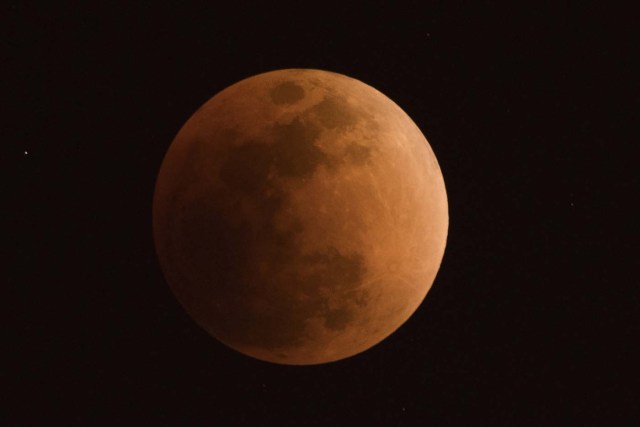
Skywatchers were hoping for a rare lunar eclipse that combines three unusual events — a blue moon, a super moon and a total eclipse — which was to make for a large crimson moon viewable in many corners of the globe. / AFP PHOTO / NICOLAS ASFOURI
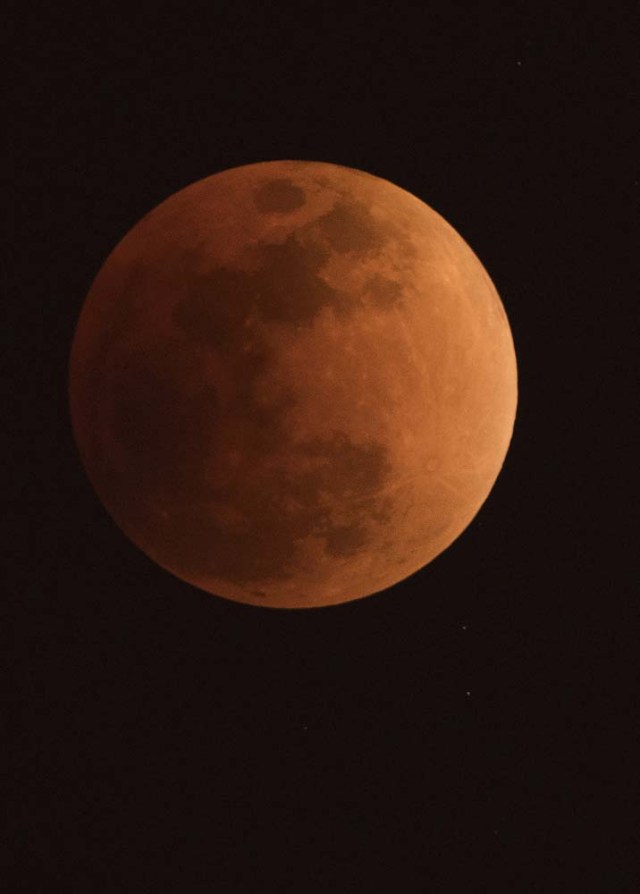
Skywatchers were hoping for a rare lunar eclipse that combines three unusual events — a blue moon, a super moon and a total eclipse — which was to make for a large crimson moon viewable in many corners of the globe. / AFP PHOTO / NICOLAS ASFOURI
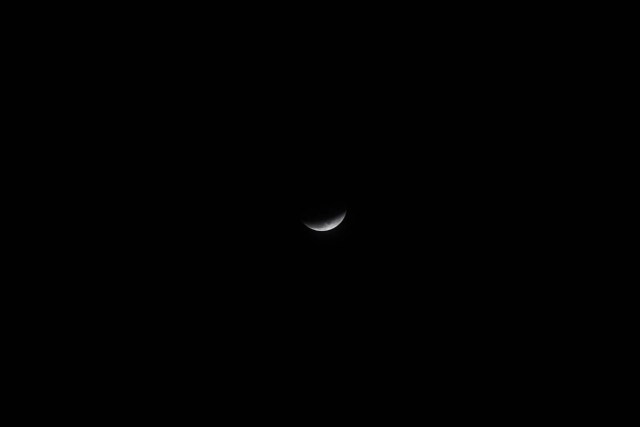
Skywatchers were hoping for a rare lunar eclipse that combines three unusual events — a blue moon, a super moon and a total eclipse — which was to make for a large crimson moon viewable in many corners of the globe. / AFP PHOTO / SAJJAD HUSSAIN
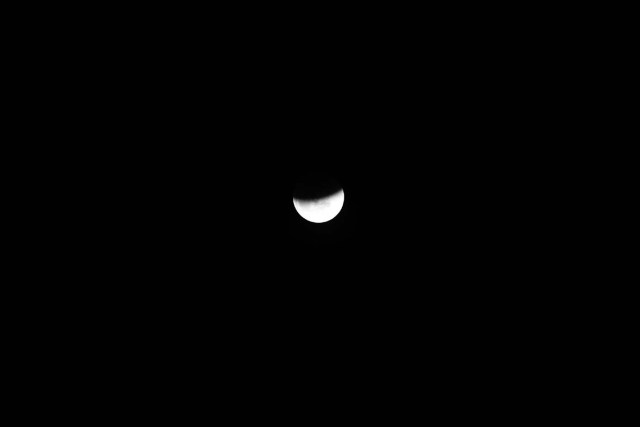
Skywatchers were hoping for a rare lunar eclipse that combines three unusual events — a blue moon, a super moon and a total eclipse — which was to make for a large crimson moon viewable in many corners of the globe. / AFP PHOTO / SAJJAD HUSSAIN
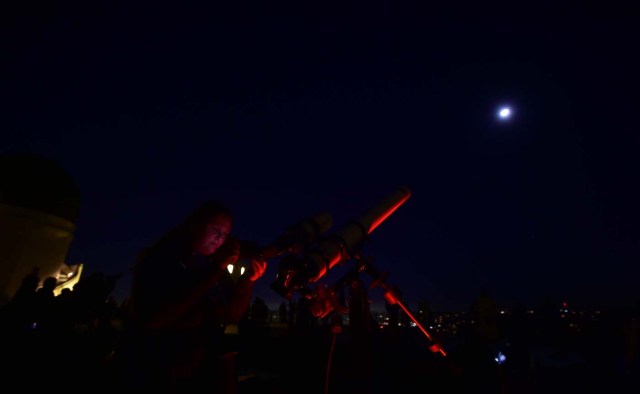
Stargazers across large swathes of the globe — from the streets of Los Angeles to the slopes of a smouldering Philippine volcano — had the chance to witness a rare “super blue blood Moon” Wednesday, when Earth’s shadow bathed our satellite in a coppery hue.The celestial show is the result of the Sun, Earth, and Moon lining up perfectly for a lunar eclipse just as the Moon is near its closest orbit point to Earth, making it appear “super” large.
/ AFP PHOTO / Frederic J. BROWN
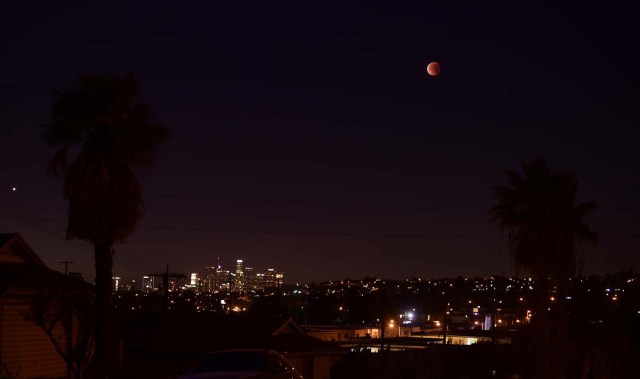
Stargazers across large swathes of the globe — from the streets of Los Angeles to the slopes of a smouldering Philippine volcano — had the chance to witness a rare “super blue blood Moon” Wednesday, when Earth’s shadow bathed our satellite in a coppery hue.The celestial show is the result of the Sun, Earth, and Moon lining up perfectly for a lunar eclipse just as the Moon is near its closest orbit point to Earth, making it appear “super” large.
/ AFP PHOTO / Frederic J. Brown
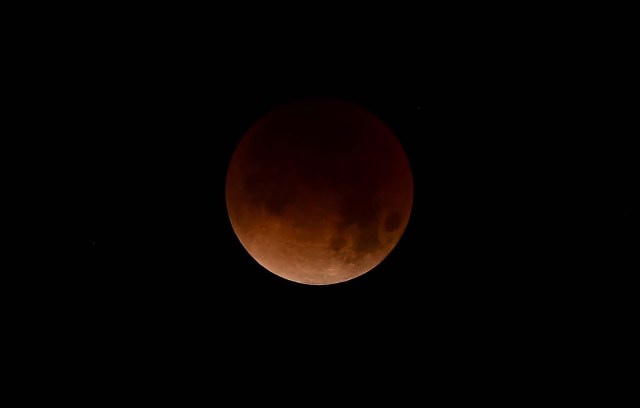
Stargazers across large swathes of the globe — from the streets of Los Angeles to the slopes of a smouldering Philippine volcano — had the chance to witness a rare “super blue blood Moon” Wednesday, when Earth’s shadow bathed our satellite in a coppery hue.The celestial show is the result of the Sun, Earth, and Moon lining up perfectly for a lunar eclipse just as the Moon is near its closest orbit point to Earth, making it appear “super” large.
/ AFP PHOTO / Frederic J. Brown
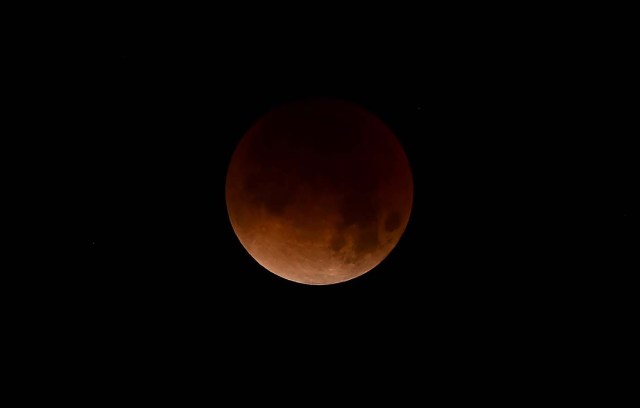
Stargazers across large swathes of the globe — from the streets of Los Angeles to the slopes of a smouldering Philippine volcano — had the chance to witness a rare “super blue blood Moon” Wednesday, when Earth’s shadow bathed our satellite in a coppery hue.The celestial show is the result of the Sun, Earth, and Moon lining up perfectly for a lunar eclipse just as the Moon is near its closest orbit point to Earth, making it appear “super” large.
/ AFP PHOTO / Frederic J. Brown
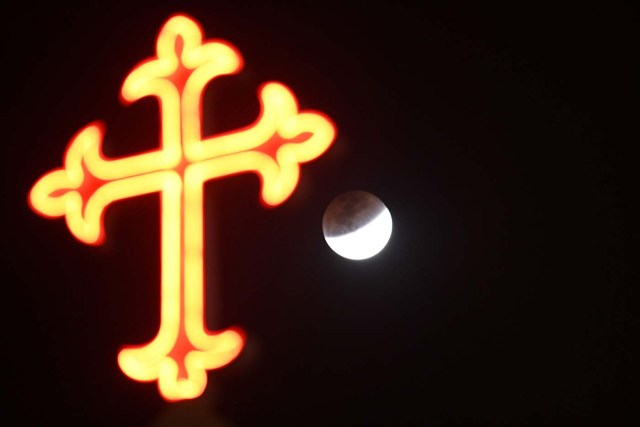
Skywatchers were hoping for a rare lunar eclipse that combines three unusual events — a blue moon, a super moon and a total eclipse — which was to make for a large crimson moon viewable in many corners of the globe / AFP PHOTO / NOAH SEELAM
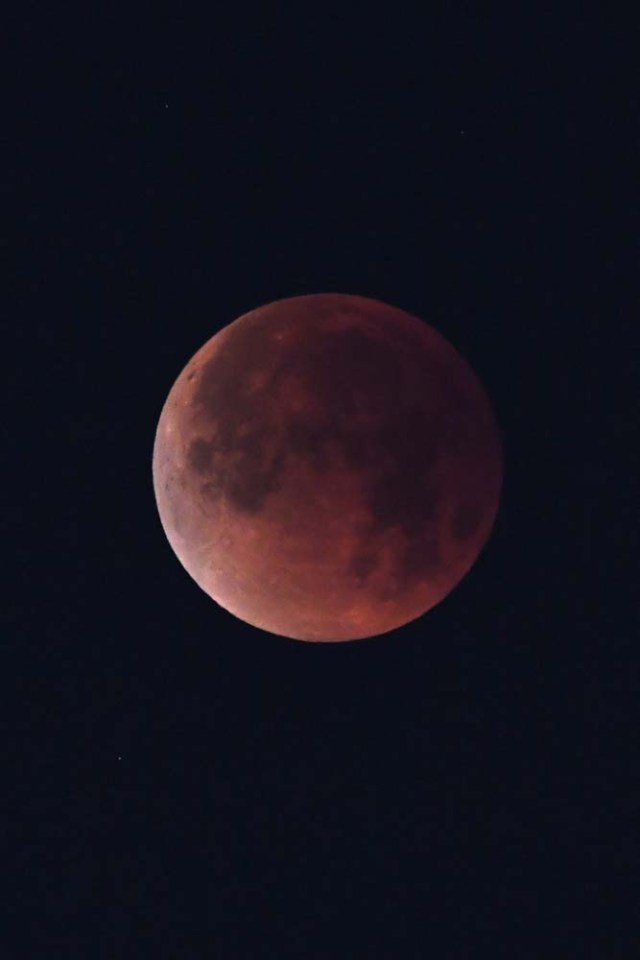
Many parts of the globe may catch a glimpse on January 31 of a giant crimson moon, thanks to a rare lunar trifecta that combines a blue moon, a super moon and a total eclipse. The spectacle, which NASA has coined a “super blue blood moon.” The celestial show is the result of the sun, Earth, and Moon lining up perfectly for a lunar eclipse just as the Moon is near its closest orbit point to Earth, making it appear “super” large.
/ AFP PHOTO / Robyn Beck
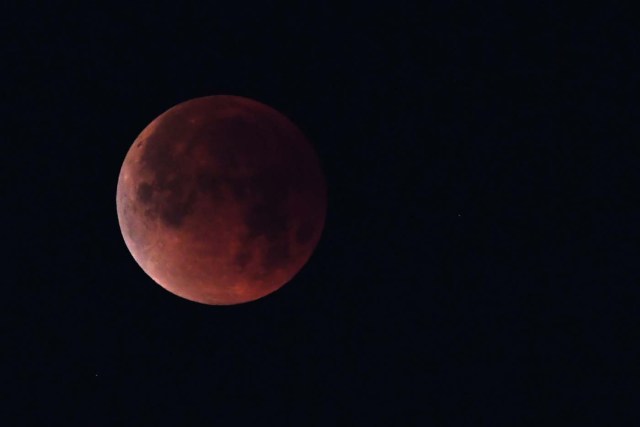
Many parts of the globe may catch a glimpse on January 31 of a giant crimson moon, thanks to a rare lunar trifecta that combines a blue moon, a super moon and a total eclipse. The spectacle, which NASA has coined a “super blue blood moon.” The celestial show is the result of the sun, Earth, and Moon lining up perfectly for a lunar eclipse just as the Moon is near its closest orbit point to Earth, making it appear “super” large.
/ AFP PHOTO / Robyn Beck
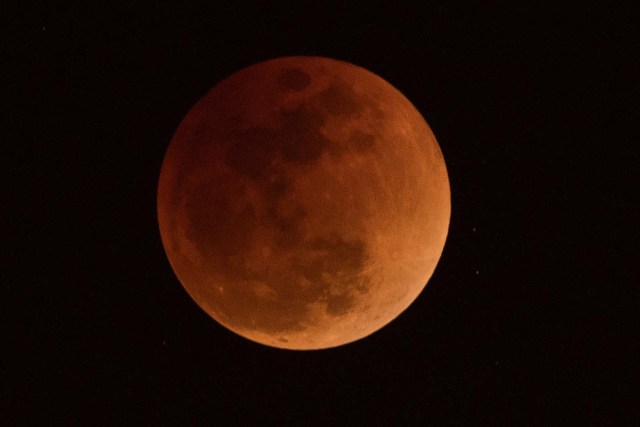
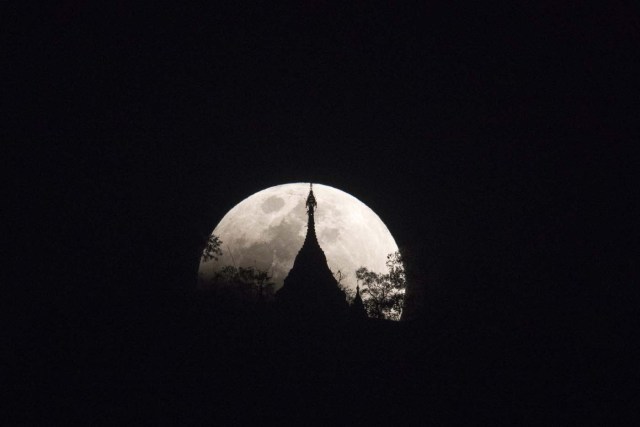
Skywatchers were hoping for a rare lunar eclipse that combines three unusual events — a blue moon, a super moon and a total eclipse — which was to make for a large crimson moon viewable in many corners of the globe. / AFP PHOTO / YE AUNG THU
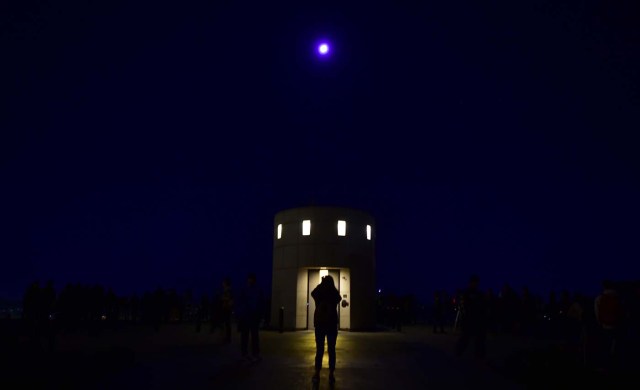
Stargazers across large swathes of the globe — from the streets of Los Angeles to the slopes of a smouldering Philippine volcano — had the chance to witness a rare “super blue blood Moon” Wednesday, when Earth’s shadow bathed our satellite in a coppery hue.The celestial show is the result of the Sun, Earth, and Moon lining up perfectly for a lunar eclipse just as the Moon is near its closest orbit point to Earth, making it appear “super” large.
/ AFP PHOTO / Frederic J. BROWN
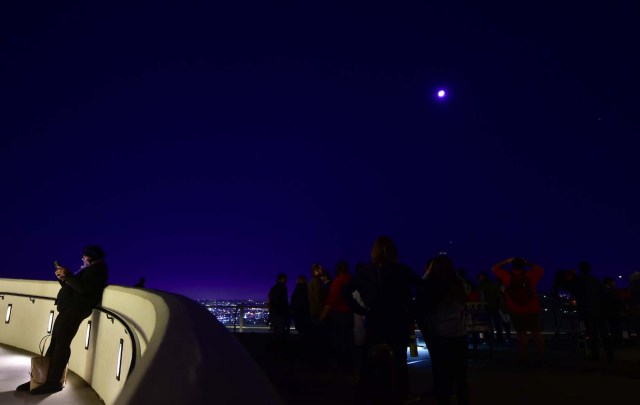
Stargazers across large swathes of the globe — from the streets of Los Angeles to the slopes of a smouldering Philippine volcano — had the chance to witness a rare “super blue blood Moon” Wednesday, when Earth’s shadow bathed our satellite in a coppery hue.The celestial show is the result of the Sun, Earth, and Moon lining up perfectly for a lunar eclipse just as the Moon is near its closest orbit point to Earth, making it appear “super” large.
/ AFP PHOTO / Frederic J. BROWN
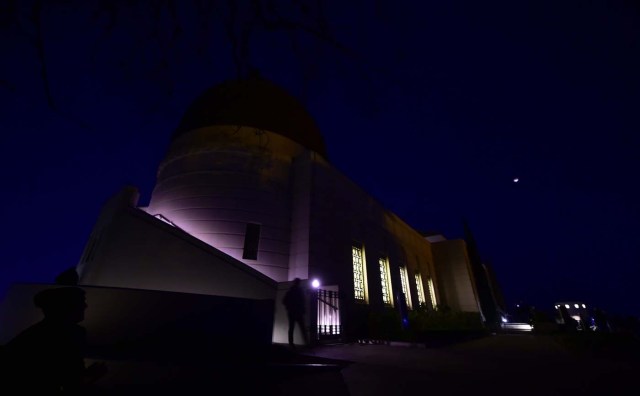
Stargazers across large swathes of the globe — from the streets of Los Angeles to the slopes of a smouldering Philippine volcano — had the chance to witness a rare “super blue blood Moon” Wednesday, when Earth’s shadow bathed our satellite in a coppery hue.The celestial show is the result of the Sun, Earth, and Moon lining up perfectly for a lunar eclipse just as the Moon is near its closest orbit point to Earth, making it appear “super” large.
/ AFP PHOTO / Frederic J. BROWN
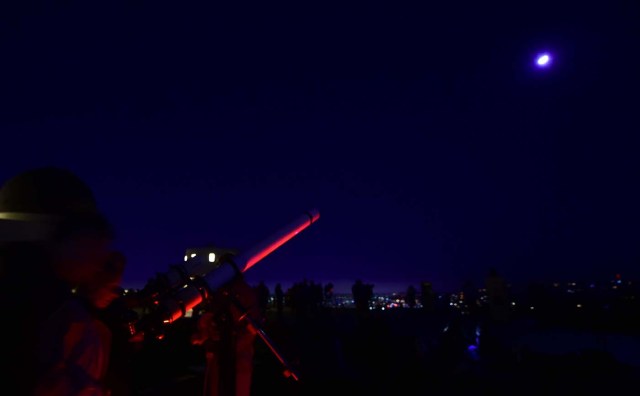
Stargazers across large swathes of the globe — from the streets of Los Angeles to the slopes of a smouldering Philippine volcano — had the chance to witness a rare “super blue blood Moon” Wednesday, when Earth’s shadow bathed our satellite in a coppery hue.The celestial show is the result of the Sun, Earth, and Moon lining up perfectly for a lunar eclipse just as the Moon is near its closest orbit point to Earth, making it appear “super” large.
/ AFP PHOTO / Frederic J. BROWN
